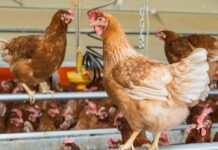
The combined effect of feed presentation parameters bears considerable implications for the digestive health and growth performance of turkeys. This topic is very relevant to the economical profitability of turkey farming because turkeys are thought to be more prone to feed refusal than broilers. We aim in the present paper to explore the intricate relationship existing between feed presentation, growth performance and gut health of turkeys and to provide recommendations to the professionals of the field. In addition, we aim at discussing the relevance of additional developments in the era of feed presentation, e.g. wet or coarse diets.
Feed form and growth performance of turkeys
Important improvements in the growth performance of poultry species have been achieved in the recent decades as a result of continuous increases in the rate of feed intake. Feed intake of birds is, therefore, a major driver of overall growth performance. Feed intake is influenced by pre- and post-absorptive clues. Such clues are markedly influenced by feed presentation.
Birds have a complex beak that contains no less than ten bones and two mechanoreceptors, namely Merkel and Herbst corpuscles. The beak provides, therefore, birds with a very developed sense of touch. A series of classical studies conducted in the late 1990s has addressed the effect of feed form, processing and particle size on the growth performance of turkeys.
Results reported in such studies and internal trials have led turkey breeding companies to recommend using medium crumble during the 0-3 week period (2.3-3 mm), large crumbles in the 3-5 week period (3-4 mm), short pellets in the 5-6 week period (4 mm diameter, 6.4 mm length) and, finally larger pellets for the reminder of the rearing period (4 mm diameter, 13-16 mm length; Hybrid, 2018). Crumble and pellets must, in addition, have a good durability (i.e.>90%, as measured with the Quick test) because the presence of fines degrades the feed intake of turkeys.
At the other end of the spectrum, over processing, e.g. Kahl hardness > 3, may also degrade the feed intake of poultry, as exemplified in broilers by Nir and coworkers (1994). Feed producers operate, therefore, in a narrow interval between over and under processing when pelleting turkey diets. An excess in any direction may affect negatively the growth performance of birds.
Aforementioned parameters are pre-absorptive clues that influence the feed intake and, ultimately, the growth performance of turkeys. Another feed presentation parameter is feed particle size, which influences not only pre-, but also post-absorptive clues regulating the feed intake of birds. This parameter can be affected by the particle size reduction method (e.g. hammer or roller mill), the grinding parameters (e.g. screen diameter or rollers opening distance) or, more simply, by feeding whole cereals. The positive effect of feeding coarse particles has been summarized by Amerah and coworkers (2007) in an authoritative review. These authors concluded, based on broiler research, that coarse particles improve gizzard development and antiperistaltic contractions (i.e. intestinal reflux; Sacranie et al., 2012). In turkeys, intestinal reflux is thought to be regulated by changes in intraduodenal pressure and, to some extent, in endocrine regulation. Such mechanisms evoke those described in broilers by Kwakkel and Moquet (2013). Coarse diets improve consistently the gastrointestinal tract development of broilers but their effects on nutrient digestibility is inconsistent across studies.
Transitions are, in addition, very critical periods in turkey rearing. It is, therefore, advised to not change multiple factors within one transition in order to avoid important drops in feed intake (e.g. feed + feeder types or formulation+ form; Hybrid, 2018). Aforementioned characteristics reflect general guidelines rather than universal solutions to achieve maximum growth performance of turkeys. Since the 1960s, the growth rate and feed intake of commercial turkey breeds has improved continuously as a results of genetic selection. Complex interactions are known to occur between feed formulation and feed processing and, consequently, feed presentation characteristics are difficult to standardize.
A constant collaboration between nutritionists and feed technologists is, therefore, required to express the maximum growth potential of modern turkey breeds. Such collaboration must be driven by field observations and performance data. This means that, in a poultry nutrition world wherein feed additives based strategies have an increasing importance, the role of formulation and technological approaches should not be underestimated.
Particle size and gut health of turkeys
In addition to a high rate of feed intake, an optimal gut health is essential in supporting the growth performance of farm animals, as highlighted recently by Celi and coworkers (2017). Feed form may also influence the gut health of poultry. Much of the evidences published on that topic originates, however, from broiler studies. Hence, following references rely on broiler literature and we assume that observed effects can be extrapolated to turkeys.
Finely ground pelleted diets dissolve in the crop and pass very quickly the gizzard. This results in a poor gastrointestinal tract stimulation and in an impaired digestive functioning, e.g. lower acidic and enzymatic secretions). As a consequence of a lack of mechanical stimulation of the gastric region, finely ground pelleted diets impair the barrier function of the gizzard. This results in skewed intestinal microbiota activity and, ultimately, in detrimental changes in intestinal morphology.
Such adverse effects can be prevented, in broilers, by feeding a more coarse – structural – diet. In addition, coarse diets are thought to have a positive influence on the protein efficiency of broilers by stimulating a complex nitrogen (N) recycling mechanism. Urinary N is refluxed from the cloaca to the ceca, where it is converted to microbial protein. It is hypothesized that coarse diets enhance a putative ileocecal reflux, thereby allowing the birds to digest microbial proteins.
The impact of feed form on the growth performance of turkeys has been confirmed by an internal trial conducted at the MiXscience research center. We compared the effect of grinding method (hammer vs roller mill) on the growth performance of turkeys fed pelleted diets. Our results indicate that feeding coarser diets (i.e. roller mill + pelleting) lowers significantly the FCR of turkeys at 105 d (-2 pts) and improves the gizzard weight (+34%; P<0.01). As a potential indicator of gut health, caecal droppings have been counted: this number was numerically lower in turkeys fed coarser diets (21 vs 13; ns). We suppose that roller-mill grinding contributes to a better gut health, thanks to a better gizzard development.
Some studies have shown that whole wheat may contribute to gut performance in broilers through the development of the GIT, especially the gizzard, and by increasing dietary nutrients absorption. A recent MiXscience trial has confirmed the benefit of whole wheat in complete feed for turkeys. The gizzard weight was significantly increased by the addition of whole wheat to a pelleted feed (+74 %).
The whole wheat has also an indirect sanitary effect on the gut: it reduces the numbers of Salmonella typhimurium and Clostridium perfringens in the intestinal tract of birds. Inclusion of whole wheat into the diet increased feed conversion efficiency in some studies whereas others have not found any positive impact on feed efficiency. In the MiXscience trial, there were no significant difference in bodyweight corrected FCR between turkeys fed with or without whole wheat.
Conclusion
Feed presentation is a broad concept that includes the form (mash, pellets, crumble), processing degree (hardness, durability), particle size (fine or coarse) and hydration (dry or wet) of the diet. Such parameters interact with each other, i.e. a coarse pelleted diets will have a low durability. Broiler research indicate, in addition, that feed presentation may influence the gut health of turkeys. Nowadays, nutritionists can modify the form, processing degree and structure of turkey diets to maximize the growth performance of birds. Additional research is required to assess the relevance of coarse diets in further improving the growth performance of turkeys.
References are available on request
From the Proceedings of the 12th Turkey Science and Production Conference

















